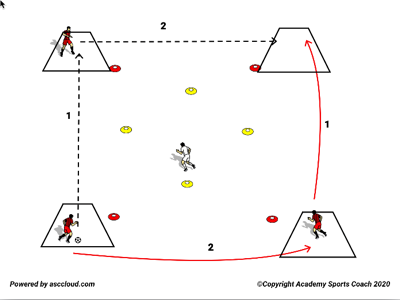In previous articles in this series (link 1, link 2), we introduced a 3v1 activity and discussed some theory on principles, intent, and outcomes. In this article, we’ll to a deeper drive into the details of the activity..
Here is a schematic of the activity. The basic rule is that the player receiving the ball should have support on both right and left:

This is a “social distance” activity, intended to conform to the USSF Phase 1 requirements being applied in California during 2020.
The basic idea is that the “3rd man” in the activity – the player who is not passing or receiving – should make a movement to the space either to the left or right of the receiver. The central player will be providing some shadow pressure and is being trained in anticipating and movements in response to the ball and opponents.
Here is picture showing the concepts that we want the players to explore in this activity (from the UC Premier curriculum, using a 4v1):

| Angles | formed by 6/11 and 6/7 |
| Distance | the amount of space between 6 and 9 |
| Lines | the relative positioning of 11 and 7 versus defender 8 |
| Timing | the movements of the players along the edge of their box relative to the movement of the ball |
In this example (an advanced version of our 3v1), the attacking players have the freedom to determine their positions relative to the horizontal and vertical lines of the box.
In our activity, the players are constrained to specific angles, distances, and lines. Because of this restriction, the 3v1 is an initial progression toward the 4v1 shown above. The variable that players influence is their timing – decisions on off-ball movements and speed of movement.
Our Principles of Play include 3 categories (manage oneself, manage space, and manage the ball) with 14 statements. Relative to our activity, these statements apply:
- Perceive and conceive
- Decide and deceive
- Execute and assess
- Attack 1, 2, 3
- Keep it simple
- Play the way you see
- Receive with intent
- Pass with purpose
- Keep and move the ball
These form the tactical messages that we will want to deliver to our players. In addition, we may consider technical messaging or corrections – for example, use of foot surface, pace of passes, receiving/preparing the ball, etc.
Here is an animated version of the activity:
An important aspect of the activity is the body shape of the receiving player. An “open” body shape – one in which the player’s hips are at 45-degree angle to the passer – supports options to play either left or right after receiving the ball.
Compare the Red and Blue teams in this picture:

The Red players (highlighted in yellow) are at a 45-degree angle to the ball carrier. The Blue players (highlighted in yellow) are facing the ball carrier. If the intent is to play the next ball to the teammate highlighted in green, the Blue players must shift their feet and open their hips, which costs time and may invite pressure.
In order for the receiving teammate (highlighted in yellow) to make a pass to the teammate highlighted in green, the passer should direct the pass to the “back” foot. In this diagram below, the passer delivers the ball to the teammate’s right foot in order to simplify the next pass to the teammate highlighted in green:

If the passer plays to the “front” foot, this is a signal to play the ball back to the original passer.
This pair of concepts – open body shape to support different passing choices and passing the ball with a purpose to a specific foot – is a foundation to more advanced activities and to the real game.
Circling back to our 3v1, we look for players to arrive at their destination with an open body shape. The simplest way to do that is to make an “angled” run:

We are looking for player 3 to arrive at the space as the ball is received by player 4. Player 3’s body shape should be “open” – supporting the decision by player 4 to pass to the “back” foot – indicating that the ball should then go to player 2 (who would be moving to the right side support of player 3) or the “front” foot – indicating the the ball should then go back to player 4.
It takes more physical effort and commitment to make the angled run and arrive with an open body shape, versus making the straight run and showing up facing away from the field. It is this physical effort and desire that we want to train with our players. Simply “ambling” across the field – going through the motions – is not good enough. The run may require the player to make lateral movements and pivot on arriving in position. We will train the athletic abilities as part of our overall player development program.
The next article will discuss the role of the defender and some cues to determine whether we need to make changes in the activity to support the progress of the players.
Comments are closed.